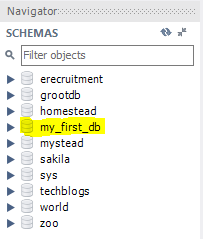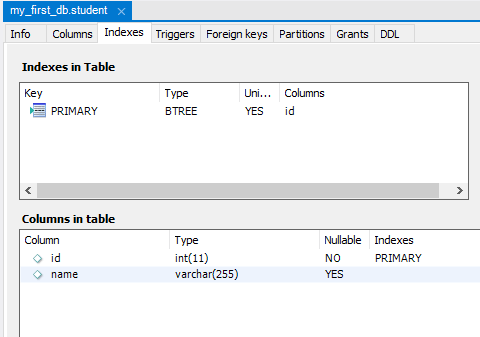Python 与 MySQL 连接:连接器、创建数据库、表、插入 [示例]
为了使用 MySQL 与 Python 的连接,您必须具备一些 SQL 知识
在深入之前,让我们了解一下
什么是 MySQL?
MySQL 是一个开源数据库,也是最好的 RDBMS(关系数据库管理系统)类型之一。 MySQLdb 的联合创始人是 Michael Widenius,MySQL 的名字也来源于 Michael 的女儿。
在本教程中,您将学习
- 什么是 MySQL?
- 如何安装 MySQL
- 为 Python 安装 MySQL 连接器库
- 使用 Python 测试 MySQL 数据库连接
- 使用 Python 在 MySQL 中创建数据库
- 使用 Python 在 MySQL 中创建表
- 使用主键创建表
- 使用 Python 在 MySQL 中更改表
- 在 Python 中使用 MySQL 插入操作
如何在 Windows、Linux/Unix 上安装 MySQL Connector Python
在 Linux/Unix 中安装 MySQL:
从官网下载适用于 Linux/Unix 的 RPM 包:https://www.mysql.com/downloads/
在终端使用以下命令
rpm -i <Package_name>
Example rpm -i MySQL-5.0.9.0.i386.rpm
签入 Linux
mysql --version
在 Windows 中安装 MySQL
从官方网站下载 MySQL 数据库 exe 并像往常一样在 Windows 中正常安装软件。请参阅本教程,了解分步指南
如何为 Python 安装 MySQL 连接器库
以下是如何将 MySQL 与 Python 连接起来:
对于 Python 2.7 或更低版本,使用 pip 进行安装:
pip install mysql-connector
对于 Python 3 或更高版本,使用 pip3 安装:
pip3 install mysql-connector
使用 Python 测试 MySQL 数据库连接
为了在 Python 中测试 MySQL 数据库连接,我们将使用预安装的 MySQL 连接器并将凭据传递到 connect() 像主机、用户名和密码这样的函数,如下面的 Python MySQL 连接器示例所示。
用 Python 访问 MySQL 的语法:
import mysql.connector
db_connection = mysql.connector.connect(
host="hostname",
user="username",
passwd="password"
) 示例 :
import mysql.connector db_connection = mysql.connector.connect( host="localhost", user="root", passwd="root" ) print(db_connection)
输出 :
<mysql.connector.connection.MySQLConnection object at 0x000002338A4C6B00>
这里的输出显示连接创建成功。
使用 Python 在 MySQL 中创建数据库
在 SQL 中创建新数据库的语法是
CREATE DATABASE "database_name"
现在我们使用 Python 中的数据库编程创建数据库
import mysql.connector
db_connection = mysql.connector.connect(
host= "localhost",
user= "root",
passwd= "root"
)
# creating database_cursor to perform SQL operation
db_cursor = db_connection.cursor()
# executing cursor with execute method and pass SQL query
db_cursor.execute("CREATE DATABASE my_first_db")
# get list of all databases
db_cursor.execute("SHOW DATABASES")
#print all databases
for db in db_cursor:
print(db) 输出 :

上图显示了 my_first_db 数据库已创建
使用 Python 在 MySQL 中创建表
让我们创建一个简单的表“student”,它有两列,如下面的 MySQL 连接器 Python 示例所示。
SQL 语法 :
CREATE TABLE student (id INT, name VARCHAR(255))
示例:
import mysql.connector
db_connection = mysql.connector.connect(
host="localhost",
user="root",
passwd="root",
database="my_first_db"
)
db_cursor = db_connection.cursor()
#Here creating database table as student'
db_cursor.execute("CREATE TABLE student (id INT, name VARCHAR(255))")
#Get database table'
db_cursor.execute("SHOW TABLES")
for table in db_cursor:
print(table) 输出 :
('student',) 使用主键创建表
让我们创建一个 Employee 具有三个不同列的表。我们将在 id 中添加一个主键 具有 AUTO_INCREMENT 约束的列,如下面的具有数据库连接的 Python 项目所示。
SQL 语法 :
CREATE TABLE employee(id INT AUTO_INCREMENT PRIMARY KEY, name VARCHAR(255), salary INT(6))
示例 :
import mysql.connector
db_connection = mysql.connector.connect(
host="localhost",
user="root",
passwd="root",
database="my_first_db"
)
db_cursor = db_connection.cursor()
#Here creating database table as employee with primary key
db_cursor.execute("CREATE TABLE employee(id INT AUTO_INCREMENT PRIMARY KEY, name VARCHAR(255), salary INT(6))")
#Get database table
db_cursor.execute("SHOW TABLES")
for table in db_cursor:
print(table) 输出 :
('employee',) ('student',) 使用 Python 在 MySQL 中更改表
Alter 命令用于修改 SQL 中的表结构。在这里我们将改变学生 表并将主键添加到 id 字段如下面的 Python MySQL 连接器项目所示。
SQL 语法 :
ALTER TABLE student MODIFY id INT PRIMARY KEY
示例 :
import mysql.connector
db_connection = mysql.connector.connect(
host="localhost",
user="root",
passwd="root",
database="my_first_db"
)
db_cursor = db_connection.cursor()
#Here we modify existing column id
db_cursor.execute("ALTER TABLE student MODIFY id INT PRIMARY KEY") 输出 :
在下面你可以看到 id 列已修改。

在 Python 中使用 MySQL 插入操作:
让我们在我们已经创建的 MySQL 数据库表中执行插入操作。我们将向 STUDENT 表和 EMPLOYEE 表插入数据。
SQL 语法 :
INSERT INTO student (id, name) VALUES (01, "John") INSERT INTO employee (id, name, salary) VALUES(01, "John", 10000)
示例 :
import mysql.connector db_connection = mysql.connector.connect( host="localhost", user="root", passwd="root", database="my_first_db" ) db_cursor = db_connection.cursor() student_sql_query = "INSERT INTO student(id,name) VALUES(01, 'John')" employee_sql_query = " INSERT INTO employee (id, name, salary) VALUES (01, 'John', 10000)" #Execute cursor and pass query as well as student data db_cursor.execute(student_sql_query) #Execute cursor and pass query of employee and data of employee db_cursor.execute(employee_sql_query) db_connection.commit() print(db_cursor.rowcount, "Record Inserted")
输出 :
2 Record Inserted
Python


